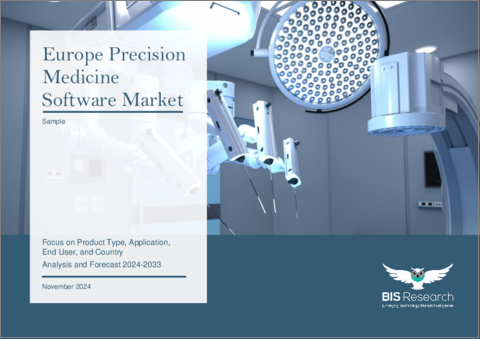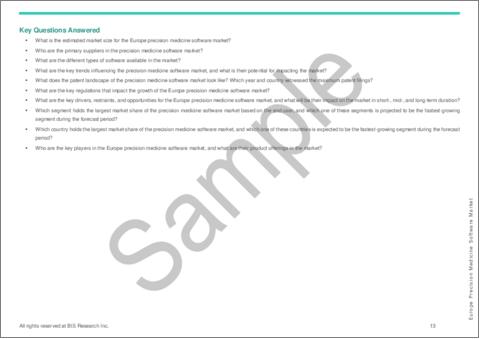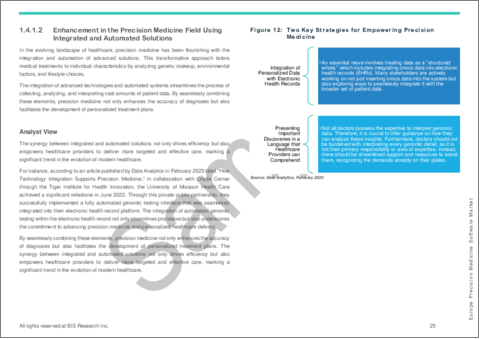|
|
市場調査レポート
商品コード
1606243
欧州の精密医療ソフトウェア市場:製品タイプ別、用途別、エンドユーザー別、国別 - 分析と予測(2024年~2033年)Europe Precision Medicine Software Market: Focus on Product Type, Application, End User, and Country - Analysis and Forecast, 2024-2033 |
||||||
カスタマイズ可能
|
|||||||
| 欧州の精密医療ソフトウェア市場:製品タイプ別、用途別、エンドユーザー別、国別 - 分析と予測(2024年~2033年) |
|
出版日: 2024年12月06日
発行: BIS Research
ページ情報: 英文 58 Pages
納期: 1~5営業日
|
全表示
- 概要
- 図表
- 目次
欧州の精密医療ソフトウェアの市場規模は、2024年に4億6,090万米ドルとなりました。
同市場は、2024年から2033年にかけて11.47%のCAGRで拡大し、2033年には12億2,470万米ドルに達すると予測されています。欧州市場において、精密医療ソフトウェアとは、ヘルスケアにおける精密医療の実施を支援するために設計された高度なデジタルツールおよびアプリケーションを指します。この個別化アプローチは、遺伝学、ライフスタイル、環境、分子または細胞プロファイルを含む個々の患者の特性に合わせた治療と意思決定に焦点を当てています。
| 主要市場統計 | |
|---|---|
| 予測期間 | 2024年~2033年 |
| 2024年の評価額 | 4億6,090万米ドル |
| 2033年の予測 | 12億2,470万米ドル |
| CAGR | 11.47% |
欧州の精密医療ソフトウェア市場は、データ分析、ゲノミクス、オーダーメードヘルスケア戦略の市場開拓により大きく拡大しています。各患者固有の遺伝子プロファイル、ライフスタイル、環境状況に合わせて医療の選択や治療をカスタマイズするためには、精密医療ソフトウェアが不可欠です。データ主導の意思決定を可能にすることで、この技術は患者の転帰、治療効果、診断精度を高めます。
精密医療ソフトウェアの導入は、欧州の強力なヘルスケアシステムとデジタルヘルスイニシアチブへの投資の増加によって加速しています。Horizon Europeのようなプログラムを通じて、欧州全域の政府や組織が遺伝子研究や精密医療を最優先課題としており、この分野のイノベーションを後押ししています。人工知能(AI)と機械学習(ML)の統合により、ソフトウェアの機能はさらに向上し、リアルタイムのデータ分析とカスタマイズされた治療計画が可能になります。
欧州では、薬理ゲノミクス、慢性疾患管理、珍しい病気の発見、腫瘍学が精密医療ソフトウェアの主な用途のひとつです。バイオインフォマティクスやビッグデータの市場開拓とともに精密ヘルスケアが重視されるようになったことで、データのプライバシー問題や高額な導入コストといった障害にもかかわらず、市場の拡大が進んでいます。
当レポートでは、欧州の精密医療ソフトウェア市場について調査し、市場の概要とともに、製品タイプ別、用途別、エンドユーザー別、国別の動向、および市場に参入する企業のプロファイルなどを提供しています。
目次
エグゼクティブサマリー
第1章 市場
- 動向:現在および将来の影響評価
- サプライチェーンの概要
- 規制状況
- 市場力学の概要
第2章 地域
- 地域別概要
- 促進要因と抑制要因
- 欧州
第3章 市場競合ベンチマーキングと企業プロファイル
- 今後の見通し
- 地理的評価
- F. Hoffmann-La Roche Ltd
- Genedata AG
- Koninklijke Philips N.V.
- QIAGEN N.V.
- SOPHiA GENETICS SA
第4章 調査手法
List of Figures
- Figure 1: Precision Medicine Software Market (by Region), $Million, 2023, 2027, and 2033
- Figure 2: Europe Precision Medicine Software Market (by Delivery Mode), $Million, 2023, 2027, and 2033
- Figure 3: Europe Precision Medicine Software Market (by Application), $Million, 2023, 2027, and 2033
- Figure 4: Europe Precision Medicine Software Market (by End User), $Million, 2023, 2027, and 2033
- Figure 5: Key Events of Precision Medicine Software Market, 2023 and 2024
- Figure 6: Role of Precision Medicine Software in Personalized Care
- Figure 7: Benefits of Using Cloud-Based Delivery Mode Technology in Healthcare
- Figure 8: Supply Chain and Risks within the Supply Chain
- Figure 9: Precision Medicine Software (by Year), January 2021-December 2023
- Figure 10: Impact Analysis of Market Navigating Factors, 2023-2033
- Figure 11: Benefits of Integrating AI with Precision Medicine
- Figure 12: Two Key Strategies for Empowering Precision Medicine
- Figure 13: France Precision Medicine Software Market, $Million, 2023-2033
- Figure 14: Germany Precision Medicine Software Market, $Million, 2023-2033
- Figure 15: U.K. Precision Medicine Software Market, $Million, 2023-2033
- Figure 16: Spain Precision Medicine Software Market, $Million, 2023-2033
- Figure 17: Italy Precision Medicine Software Market, $Million, 2023-2033
- Figure 18: Rest-of-Europe Precision Medicine Software Market, $Million, 2023-2033
- Figure 19: Strategic Initiatives, 2021-2023
- Figure 20: Share of Strategic Initiatives, 2021-2023
- Figure 21: Data Triangulation
- Figure 22: Top-Down and Bottom-Up Approach
- Figure 23: Assumptions and Limitations
List of Tables
- Table 1: Market Snapshot
- Table 2: Opportunities across Regions
- Table 3: Precision Medicine Software Market Trend Analysis
- Table 4: Cloud-Based Delivery Mode-Based Platform
- Table 5: Role of EHRs in Advancing Precision Medicine
- Table 6: Precision Medicine Software (by Region), $Million, 2023-2033
- Table 7: Europe Precision Medicine Software Market (by Application), $Million, 2023-2033
- Table 8: Europe Precision Medicine Software Market (by End User), $Million, 2023-2033
- Table 9: Europe Precision Medicine Software Market (by Delivery Mode), $Million, 2023-2033
Introduction to Europe Precision Medicine Software Market
The Europe precision medicine software market was valued at $460.9 million in 2024 and is expected to reach $1,224.7 million by 2033, growing at a CAGR of 11.47% between 2024 and 2033. In the Europe market, precision medicine software refers to advanced digital tools and applications designed to support the implementation of precision medicine in healthcare. This personalized approach focuses on tailoring medical treatments and decisions to individual patient characteristics, including genetics, lifestyle, environment, and molecular or cellular profiles.
Market Introduction
| KEY MARKET STATISTICS | |
|---|---|
| Forecast Period | 2024 - 2033 |
| 2024 Evaluation | $460.9 Million |
| 2033 Forecast | $1,224.7 Million |
| CAGR | 11.47% |
The market for precision medicine software in Europe is expanding significantly due to developments in data analytics, genomics, and tailored healthcare strategies. In order to customize medical choices and treatments to each patient's unique genetic profile, lifestyle, and environmental circumstances, precision medicine software is essential. By enabling data-driven decision-making, this technology enhances patient outcomes, treatment effectiveness, and diagnostic precision.
Precision medicine software adoption is being accelerated by Europe's strong healthcare system and rising investments in digital health initiatives. Through programs like Horizon Europe, governments and organizations throughout the continent are giving genetic research and precision healthcare top priority, which is encouraging innovation in the field. The software's capabilities are further improved by the integration of artificial intelligence (AI) and machine learning (ML), which permits real-time data analysis and customized treatment planning.
In Europe, pharmacogenomics, chronic disease management, uncommon disease detection, and oncology are among the main uses of precision medicine software. The increased emphasis on precision healthcare, along with developments in bioinformatics and big data, is propelling market expansion despite obstacles such data privacy issues and high implementation costs.
The market for precision medicine software is expected to be crucial in improving patient care and advancing personalized medicine, as Europe continues to lead the world in the adoption of cutting-edge healthcare technologies.
Market Segmentation
Segmentation 1: by Delivery Mode
- On-Premises Delivery Mode
- Cloud-Based Delivery Mode
Segmentation 2: by Application
- Oncology
- Cardiovascular
- Rare Diseases
- Others
Segmentation 3: by End User
- Healthcare Providers
- Research Centers and Government Institutes
- Pharmaceutical and Biotechnology Companies
- Other End Users
Segmentation 4: by Country
- Germany
- U.K.
- France
- Italy
- Spain
- Rest-of-Europe
How can this report add value to an organization?
Product/Innovation Strategy: The Europe precision medicine software market has been segmented based on various categories, such as product type, application, and end user.
Competitive Strategy: The Europe precision medicine software market is a highly fragmented market, with many smaller and private companies constantly entering the market. Key players in the precision medicine software market analyzed and profiled in the study involve established players that offer various kinds of products.
Key Market Players and Competition Synopsis
The companies profiled have been selected based on inputs gathered from primary experts and analyzing company coverage, product portfolio, and market penetration.
Some prominent names established in this market are:
- F. Hoffmann-La Roche Ltd
- Genedata AG
- Koninklijke Philips N.V.
- QIAGEN N.V.
- SOPHiA GENETICS SA
Table of Contents
Executive Summary
Scope and Definition
1 Markets
- 1.1 Trends: Current and Future Impact Assessment
- 1.1.1 Rise in Personalized Healthcare
- 1.1.2 Cloud-Based Delivery Mode-Based Platforms Elevating Data Accessibility
- 1.2 Supply Chain Overview
- 1.2.1 Value Chain Analysis
- 1.3 Regulatory Landscape
- 1.4 Market Dynamics Overview
- 1.4.1 Market Drivers
- 1.4.1.1 Utilizing Artificial Intelligence and Precision Medicine Together
- 1.4.1.2 Enhancement in the Precision Medicine Field Using Integrated and Automated Solutions
- 1.4.2 Market Restraints
- 1.4.2.1 Data Safety and Privacy Concerns
- 1.4.3 Market Opportunities
- 1.4.3.1 Leveraging Electronic Health Records in the Market
- 1.4.1 Market Drivers
2 Regions
- 2.1 Regional Summary
- 2.2 Drivers and Restraints
- 2.3 Europe
- 2.3.1 Regional Overview
- 2.3.2 Driving Factors for Market Growth
- 2.3.3 Factors Challenging the Market
- 2.3.4 Application
- 2.3.5 Product
- 2.3.6 France
- 2.3.7 Germany
- 2.3.8 U.K.
- 2.3.9 Spain
- 2.3.10 Italy
- 2.3.11 Rest-of-Europe
3 Markets Competitive Benchmarking & Company Profiles
- 3.1 Next Frontiers
- 3.2 Geographic Assessment
- 3.2.1 F. Hoffmann-La Roche Ltd
- 3.2.1.1 Overview
- 3.2.1.2 Top Products/Product Portfolio
- 3.2.1.3 Target Customers
- 3.2.1.4 Key Personnel
- 3.2.1.5 Analyst View
- 3.2.2 Genedata AG
- 3.2.2.1 Overview
- 3.2.2.2 Top Products/Product Portfolio
- 3.2.2.3 Target Customers
- 3.2.2.4 Key Personnel
- 3.2.2.5 Analyst View
- 3.2.3 Koninklijke Philips N.V.
- 3.2.3.1 Overview
- 3.2.3.2 Top Products/Product Portfolio
- 3.2.3.3 Target Customers
- 3.2.3.4 Key Personnel
- 3.2.3.5 Analyst View
- 3.2.4 QIAGEN N.V.
- 3.2.4.1 Overview
- 3.2.4.2 Top Products/Product Portfolio
- 3.2.4.3 Target Customers
- 3.2.4.4 Key Personnel
- 3.2.4.5 Analyst View
- 3.2.5 SOPHiA GENETICS SA
- 3.2.5.1 Overview
- 3.2.5.2 Top Products/Product Portfolio
- 3.2.5.3 Target Customers
- 3.2.5.4 Key Personnel
- 3.2.5.5 Analyst View
- 3.2.1 F. Hoffmann-La Roche Ltd
4 Research Methodology
- 4.1 Data Sources
- 4.1.1 Primary Data Sources
- 4.1.2 Secondary Data Sources
- 4.1.3 Data Triangulation
- 4.2 Market Estimation and Forecast






